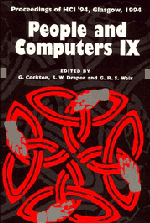Book contents
- Frontmatter
- Contents
- Preface: HCI'94 – You Probably Haven't Seen It All Before
- Part I Invited Papers
- Part II Methodology of Interactive Systems Development
- 3 Transferring HCI Modelling and Design Techniques to Practitioners: A Framework and Empirical Work
- 4 The Use of Visual Indexing as an Interview Support Technique
- 5 A Domain Analysis of Air Traffic Management Work can be Used to Rationalise Interface Design Issues
- 6 Manuals as Structured Programs
- 7 Improving Education through Computer-Based Alternative Assessment Methods
- 8 Visual Programming in a Visual Domain: A Case Study of Cognitive Dimensions
- 9 Evaluating Evaluation Methods
- Crafting Interaction: Styles, Metaphors, Modalities and Agents
- Modelling Humans, Computers and their Interaction
- Notations and Tools for Design
- Part VI Computer-Supported Cooperative Work
- Author Index
- Keyword Index
6 - Manuals as Structured Programs
Published online by Cambridge University Press: 04 August 2010
- Frontmatter
- Contents
- Preface: HCI'94 – You Probably Haven't Seen It All Before
- Part I Invited Papers
- Part II Methodology of Interactive Systems Development
- 3 Transferring HCI Modelling and Design Techniques to Practitioners: A Framework and Empirical Work
- 4 The Use of Visual Indexing as an Interview Support Technique
- 5 A Domain Analysis of Air Traffic Management Work can be Used to Rationalise Interface Design Issues
- 6 Manuals as Structured Programs
- 7 Improving Education through Computer-Based Alternative Assessment Methods
- 8 Visual Programming in a Visual Domain: A Case Study of Cognitive Dimensions
- 9 Evaluating Evaluation Methods
- Crafting Interaction: Styles, Metaphors, Modalities and Agents
- Modelling Humans, Computers and their Interaction
- Notations and Tools for Design
- Part VI Computer-Supported Cooperative Work
- Author Index
- Keyword Index
Summary
A user manual may provide instructions that, if the user follows them, achieve any of certain objectives as determined by the manual designers. A manual may therefore be viewed rather like a computer program, as pre-planned instructions. Accordingly, software engineering and its methods may be applied mutatis mutandis to the manual and its design process.
We consider structured programming methods, and show that some difficulties with user interfaces may be attributed to manuals being ‘unstructured’. Since there are many programming metrics, and very many styles of manuals for user interfaces, this paper is concerned with justifying the approach and showing how insightful it is.
Keywords: manuals, hypertext, multimedia, finite state machines, flowgraphs.
Introduction
There is much evidence that improved manuals improve user acceptance (Carroll, 1990). There is also the argument that improving manuals by changing the system documented by them leads to improved systems (Thimbleby, 1990). Thus manuals are an essential part of the system life cycle: from requirements and design, through usability, to acceptance.
The importance of manuals certainly extends beyond their use in training and reference. In some sense (whether this is explicit or implicit) a user must ‘know’ what they are doing to use a system, and the manual is a representation of what they could know. Whether a user could in practice verbalise their knowledge as a system manual is unlikely — it may not even be necessary to be able to do so if the system feedback is sufficient, cf. (Payne, 1991); however it is certain that, for many users, the manual is the prime input to their initial system knowledge.
- Type
- Chapter
- Information
- People and Computers , pp. 67 - 80Publisher: Cambridge University PressPrint publication year: 1994
- 2
- Cited by

